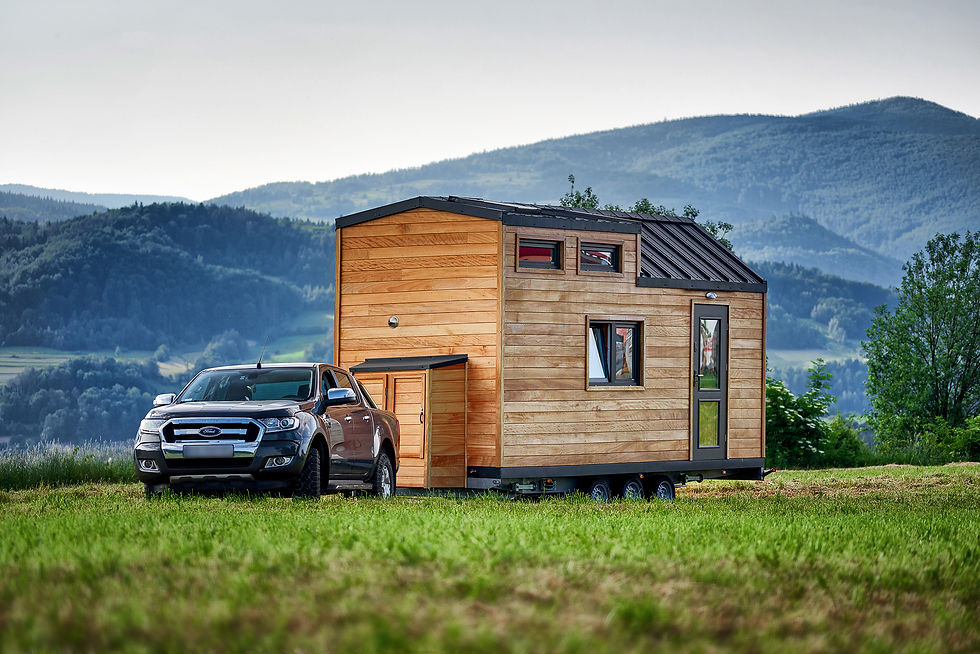Tiny House History
- Vagabond Haven

- May 11, 2022
- 3 min read
How and when did the Tiny House Movement start and how did it become so popular?

I saw my first tiny houses when travelling in New Zealand about two decades ago. They were brilliant, quirky creations rolling on the backstreets of the country, looking like something escaped from a children’s book, all helter-skelter woodwork, lopsided roofs, coloured windows and pull-out verandas. Probably home-built, probably built with as much fun as one can have building anything!
It was on the same trip that I became friends with Emery and Dawn, a wonderful couple in their 70s, who lived in a remodelled schoolbus somewhere in the New Zealand bush. They had lived in this and other self-made homes for most of their grown-up lives. For them tiny houses were nothing new - they had been around since quite a while.
But just how long, exactly? When did the tiny house movement start?
One could argue that tiny houses have been around since the very beginning of our species' architectural endeavours. Because, clearly, before we started to build villas, mansions, and castles, we have built simpler and smaller shelters. And even farther down the history road, closer to modern times, when sophisticated houses became the norm, and when bigger became better, there have always been wandering people, nomads, gypsies, and other traveling folks continuing to live in smaller and often mobile homes.
The tiny house movement as an outspoken counter movement, however, is quite a recent phenomenon: it started only about 20-30 years ago as a culturally popularized alternative to the modern trend of the average home becoming ever bigger and more expensive, and it started in the USA.
Here is a very rough synopsis of some of the important milestones of this movement. From the first cultural expressions in the form of 70s - 90s literature; over Jay Shafer’s and other pioneers' first appearances in the mainstream media; to the 2008 mortgage crisis that gave the movement an urgency and increased momentum; and finally the internet boosted hype in the following decade that turned tiny house living from a fringe movement to something most everybody has heard about:

1973
Lloyd Kahn and Bob Easton release the compendium Shelter, one of my absolutely favourite books “… about simple homes, natural materials, and human resourcefulness […] about discovery, hard work, the joys of self-sufficiency, and freedom”.
1998
Sarah Susankas The Not So Big House becomes a bestseller. It’s a call for a shift from quantity to quality, maximizing the use of space rather than space itself.

2000
University professor Jay Shafer’s tiny house features the front-page of a Newspaper in Iowa, drawing a lot of interest. At around the same time Shafer also starts the first professional tiny home selling company - Tumbleweeds Tiny House Company.
2002
Together with Gregory Johnson, Nigel Valdez and Shay Salomon, Shafer forms the Small Houses Society in 2002 aiming to support research and development of smaller living spaces.

2007-2008
In the wake of the mortgage crisis, the housing market hits rock bottom, causing the interest in tiny houses to spike to unprecedented heights.

2009-present
Helped by the internet and social media, tiny houses receive massive media coverage. TV shows such as Tiny House Nation and Tiny House Hunters, numerous blogs, and books increase the popularity of tiny homes and make them accessible to the wider public. Beside DIYers, more and more professional tiny home builders pop up not just in the USA and Oceania, but even in countries such as Japan, Spain, Britain, and Germany.
The tiny house movement moves beyond the individual: In recent years more and more organisations, towns and counties recognize the potential of tiny homes as a solution for housing shortages and more efficient land use.



Comments